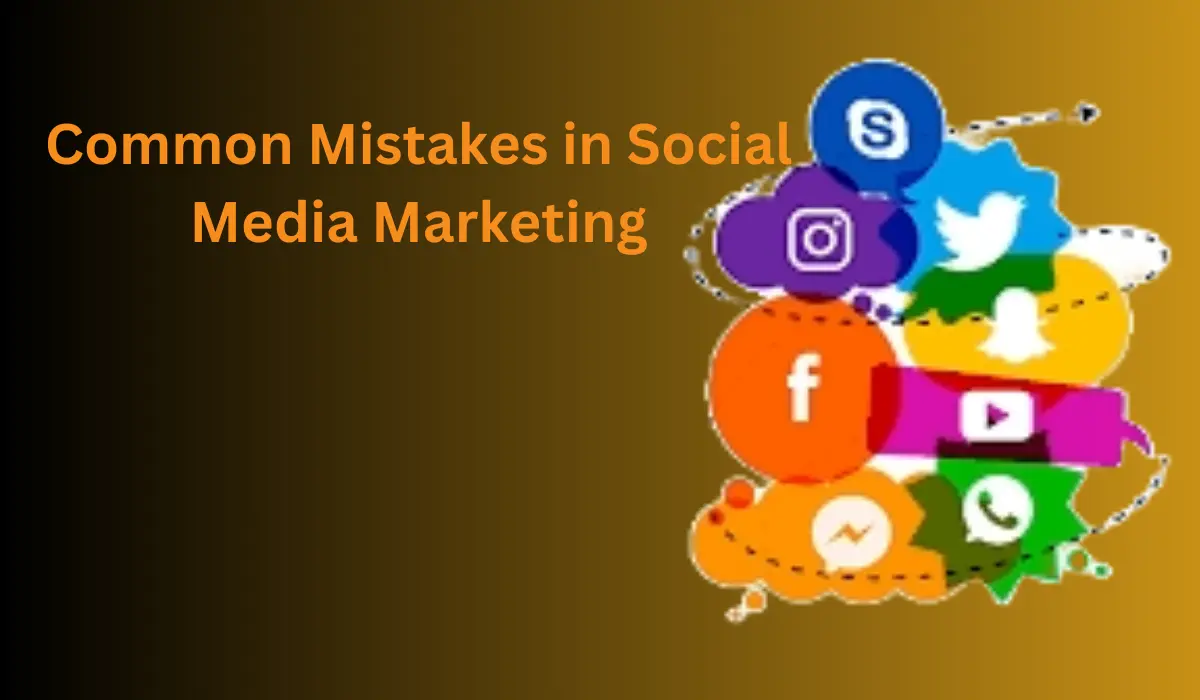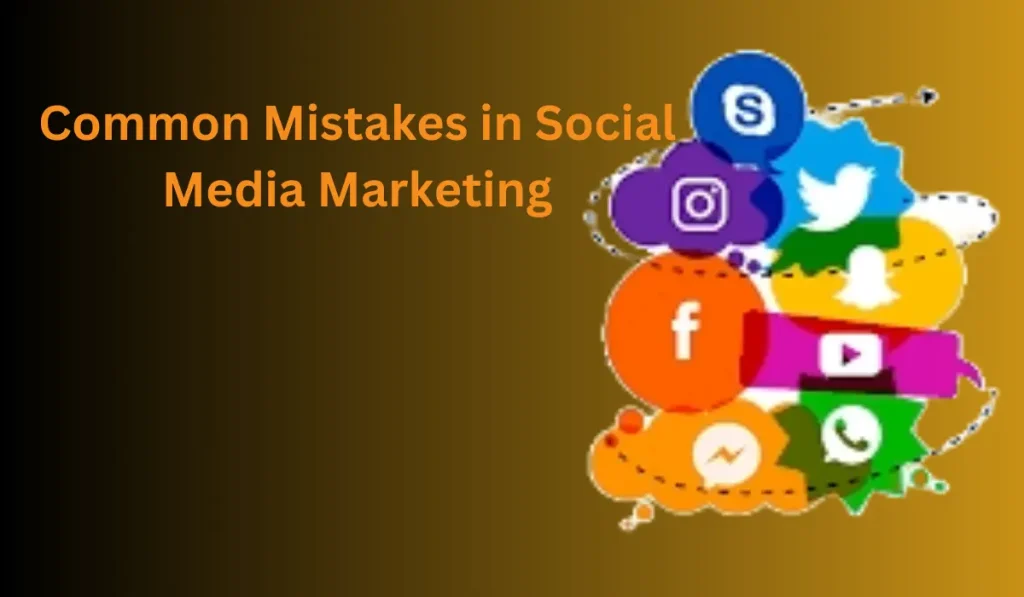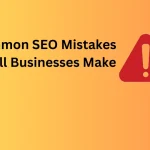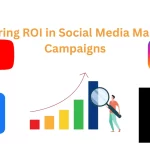In today’s digital age, social media has become an indispensable tool for businesses seeking to expand their reach, engage with customers, and build brand awareness. However, while the potential benefits of social media marketing are vast, so too are the pitfalls that can hinder success. In this article, we’ll explore some of the most common mistakes in social media marketing and provide tips on how to avoid them.
Most Common Mistakes in Social Media Marketing
Several common mistakes frequently occur in social media marketing campaigns. Here are some of the most prevalent ones:
Not Defining Clear Objectives:
“Not defining clear objectives” is indeed one of the common mistakes in social media marketing. When businesses fail to establish specific and measurable goals for their social media efforts, they lack direction and clarity. Without clear objectives, it becomes challenging to develop a focused strategy, allocate resources effectively, and measure the success of their campaigns.
Defining clear objectives allows businesses to:
Set Priorities: Clear objectives help prioritize efforts and resources towards activities that align with business goals. Whether it’s increasing brand awareness, driving website traffic, generating leads, or boosting sales, having defined objectives ensures that all social media activities contribute to overarching business objectives.
Measure Success: Clear objectives provide a benchmark for measuring the success of social media campaigns. By establishing specific metrics tied to each objective, businesses can track their progress and evaluate the effectiveness of their efforts. This allows for data-driven decision-making and optimization of future campaigns.
Guide Strategy Development: Objectives serve as a roadmap for developing a targeted social media strategy. They inform decisions regarding content creation, audience targeting, platform selection, posting frequency, and engagement tactics. A well-defined strategy aligned with clear objectives increases the likelihood of achieving desired outcomes.
Enhance Accountability: With clear objectives in place, stakeholders have a clear understanding of what is expected and can be held accountable for delivering results. This fosters accountability and ensures that everyone involved in social media marketing efforts is working towards common goals.
To avoid the mistake of not defining clear objectives in social media marketing:
- Take the time to identify specific goals that align with your business objectives.
- Ensure that objectives are measurable, achievable, relevant, and time-bound (SMART).
- Communicate objectives effectively to all stakeholders involved in social media marketing efforts.
- Regularly review and adjust objectives as needed based on performance data and evolving business priorities.
By defining clear objectives, businesses can focus their social media efforts, track progress effectively, and ultimately achieve greater success in reaching their target audience and driving desired outcomes.
Ignoring Audience Research:
Yes, “ignoring audience research” is another prevalent mistake in social media marketing. Audience research is crucial for understanding the demographics, behaviors, preferences, and interests of your target audience. Failing to conduct thorough audience research can result in ineffective content, poor engagement, and wasted resources.
Here’s why audience research is essential in social media marketing:
Targeted Content Creation: Audience research provides valuable insights into your target audience’s preferences, interests, and pain points. Armed with this knowledge, you can create content that resonates with your audience, addresses their needs, and adds value to their lives. Tailoring your content to your audience’s preferences increases engagement and encourages interaction.
Effective Audience Targeting: Social media platforms offer sophisticated targeting options that allow you to reach specific segments of your audience based on demographics, interests, behaviors, and more. Audience research helps you identify the characteristics of your ideal customers, enabling you to target your social media ads and content to those most likely to be interested in your products or services.
Improved Engagement and Interaction: Understanding your audience allows you to craft messaging that speaks directly to their interests and concerns. When your content resonates with your audience, they are more likely to engage with it by liking, commenting, sharing, or clicking through to your website. Engaging content fosters meaningful interactions, builds relationships, and increases brand loyalty.
Better Return on Investment (ROI): By targeting your social media efforts towards a well-defined audience, you can maximize the return on your investment. Instead of wasting resources on reaching irrelevant or uninterested individuals, you can focus your efforts on those most likely to convert into customers. This targeted approach leads to higher conversion rates, increased sales, and improved ROI.
To avoid the mistake of ignoring audience research in social media marketing:
- Conduct comprehensive audience research to gain insights into the demographics, interests, behaviors, and preferences of your target audience.
- Utilize tools such as social media analytics, surveys, customer feedback, and market research to gather data about your audience.
- Segment your audience based on relevant criteria to tailor your content and messaging to specific groups.
- Regularly monitor and analyze audience engagement metrics to refine your targeting and content strategy over time.
By investing time and resources into audience research, businesses can create more targeted, relevant, and engaging social media content that resonates with their audience and drives better results.
Lack of Platform Tailoring:
“lack of platform tailoring” is a common mistake in social media marketing. Each social media platform has its unique characteristics, audience demographics, content formats, and engagement strategies. Failing to tailor your content to fit the specific nuances of each platform can result in reduced effectiveness and missed opportunities for engagement.
Here’s why platform tailoring is essential in social media marketing:
Audience Preferences: Different social media platforms attract distinct demographics and user behaviors. For example, Instagram tends to skew younger with a focus on visual content, while LinkedIn caters to professionals seeking industry-related news and networking opportunities. By tailoring your content to fit the preferences of each platform’s audience, you can increase engagement and resonance.
Content Formats: Each social media platform supports various content formats, including text posts, images, videos, stories, and live streams. Tailoring your content to match the preferred formats of each platform ensures that it is presented most engagingly and effectively. For instance, visually appealing images may perform well on Instagram, whereas informative articles or industry updates may be better suited for LinkedIn.
Optimized Posting Times: The timing of your posts can significantly impact their visibility and reach on social media platforms. Audience activity levels and peak engagement times vary across platforms. By tailoring your posting schedule to align with the optimal times for each platform, you can maximize the likelihood of your target audience seeing and interacting with your content.
Platform-Specific Features: Social media platforms regularly introduce new features and functionalities that can enhance the visibility and engagement of your content. For example, Instagram offers features such as Stories, IGTV, and Reels, while Twitter has features like Twitter Chats and Polls. By leveraging platform-specific features in your content strategy, you can take advantage of new opportunities to connect with your audience and stand out from competitors.
To avoid the mistake of lacking platform tailoring in social media marketing:
- Research to understand the demographics, behaviors, and preferences of your audience on each social media platform.
- Tailor your content to match the unique characteristics and content formats of each platform.
- Customize your posting schedule and frequency based on the optimal times for audience engagement on each platform.
- Stay informed about new features and functionalities introduced by social media platforms and incorporate them into your content strategy where relevant.
By tailoring your content to fit the specific nuances of each social media platform, you can maximize engagement, reach, and effectiveness in your social media marketing efforts.
Neglecting Engagement:
Neglecting engagement is a significant mistake in social media marketing. Social media platforms are designed for interaction and conversation, and failing to actively engage with your audience can result in missed opportunities to build relationships, foster loyalty, and drive conversions.
Here are some reasons why engagement is crucial in social media marketing:
Builds Relationships: Engaging with your audience humanizes your brand and helps build genuine relationships with your followers. Responding to comments, messages, and mentions shows that you value their feedback and care about their opinions. This interaction fosters trust and loyalty, encouraging repeat engagement and advocacy for your brand.
Increases Reach and Visibility: Social media algorithms prioritize content that generates high levels of engagement. Posts with likes, comments, shares, and other interactions are more likely to be shown to a wider audience. By actively engaging with your audience and encouraging them to interact with your content, you can improve its reach and visibility organically.
Provides Valuable Feedback: Engaging with your audience allows you to gather valuable insights and feedback about your products, services, and brand perception. Monitoring comments and messages can help you identify common questions, concerns, and pain points among your audience. This information can inform product development, marketing strategies, and customer service initiatives.
Encourages User-Generated Content: Engaging with your audience can also inspire user-generated content (UGC), where customers create and share content related to your brand. UGC is highly authentic and trustworthy, as it comes directly from satisfied customers. By fostering a community of engaged followers, you can encourage UGC and leverage it to enhance your brand’s credibility and reach.
To avoid neglecting engagement in social media marketing:
- Respond promptly to comments, messages, and mentions from your audience. Acknowledge feedback, answer questions, and address concerns in a timely and personalized manner.
- Encourage conversation and interaction by asking questions, conducting polls, and soliciting feedback from your audience.
- Foster a sense of community by actively participating in relevant discussions, sharing user-generated content, and showcasing customer testimonials.
- Monitor social media mentions and brand tags to identify opportunities for engagement and relationship-building.
- Use social media listening tools to track conversations about your brand and industry, and respond proactively to both positive and negative sentiments.
By prioritizing engagement and actively interacting with your audience on social media, you can strengthen relationships, increase brand awareness, and drive meaningful results for your business.
Inconsistency in Posting:
Inconsistency in posting is a common mistake in social media marketing that can hinder the effectiveness of your efforts. Maintaining a consistent posting schedule is crucial for keeping your audience engaged, building brand presence, and maximizing the impact of your content.
Here’s why consistency in posting is important in social media marketing:
Maintains Audience Engagement: Consistently posting content keeps your brand top-of-mind for your audience. When followers know when to expect new content from you, they are more likely to engage with your posts, share them with others, and participate in discussions. Inconsistent posting can lead to a drop in engagement and interest over time.
Increases Visibility: Social media algorithms favor accounts that post regularly and consistently. Platforms like Facebook, Instagram, and Twitter prioritize recent and active accounts in users’ feeds. By consistently posting quality content, you increase your chances of appearing in your followers’ feeds, maximizing your visibility and reach.
Builds Brand Trust and Authority: Consistency in posting demonstrates reliability and commitment to your audience. It signals that your brand is active, engaged, and invested in providing value to its followers. Over time, this consistency builds trust and establishes your brand as a credible authority in your industry or niche.
Drives Traffic and Conversions: Regularly sharing valuable content keeps your audience engaged and encourages them to visit your website, explore your products or services, and take desired actions. Whether it’s signing up for a newsletter, making a purchase, or filling out a contact form, consistent posting can drive traffic and conversions for your business.
To avoid the mistake of inconsistency in posting in social media marketing:
- Create a content calendar outlining your posting schedule, content themes, and planned posts in advance.
- Use scheduling tools like Buffer, Hootsuite, or Sprout Social to plan and automate your posts, ensuring consistent delivery even during busy periods.
- Experiment with different posting frequencies and times to find what works best for your audience and industry.
- Repurpose and recycle evergreen content to maintain consistency without sacrificing quality.
- Monitor engagement metrics and adjust your posting strategy based on audience feedback and performance data.
By maintaining a consistent posting schedule and delivering valuable content to your audience regularly, you can increase engagement, build brand loyalty, and drive tangible results for your social media marketing efforts.
Also Read
Ignoring Analytics and Measurement:
“Ignoring analytics and measurement” is a significant oversight in social media marketing. Tracking and analyzing key performance metrics are essential for understanding your efforts’ effectiveness, identifying improvement areas, and making data-driven decisions to optimize your strategy.
Here’s why paying attention to analytics and measurement is crucial in social media marketing:
Performance Evaluation: Analytics provide valuable insights into how your social media content is performing. By tracking metrics such as reach, engagement, click-through rates, conversions, and follower growth, you can assess the success of your campaigns and determine which tactics are driving the best results.
Audience Insights: Analytics tools offer insights into your audience demographics, behaviors, and preferences. Understanding who your audience is and how they interact with your content allows you to tailor your strategy to better meet their needs and interests. You can identify trends, preferences, and pain points among your audience, enabling you to create more relevant and engaging content.
ROI Measurement: Analyzing social media metrics helps you evaluate the return on investment (ROI) of your marketing efforts. By tracking metrics such as conversion rates, customer acquisition costs, and revenue generated from social media campaigns, you can determine whether your investment in social media is yielding positive returns and adjust your strategy accordingly.
Strategy Optimization: Analytics data provides valuable insights for optimizing your social media strategy. By identifying which types of content, posting times, and engagement tactics resonate most with your audience, you can refine your approach to maximize effectiveness. Continuously monitoring analytics allows you to iterate on your strategy, experiment with new tactics, and improve performance over time.
To avoid the mistake of ignoring analytics and measurement in social media marketing:
- Set clear objectives and define key performance indicators (KPIs) aligned with your goals.
- Use analytics tools provided by social media platforms, such as Facebook Insights, Twitter Analytics, and LinkedIn Analytics, to track and measure relevant metrics.
- Implement UTM parameters and trackable links to monitor the effectiveness of your social media campaigns in driving website traffic and conversions.
- Regularly analyze and interpret your analytics data to identify trends, patterns, and areas for improvement.
- Use insights from analytics to inform strategic decisions, optimize content performance, and allocate resources effectively.
By embracing analytics and measurement in your social media marketing efforts, you can gain valuable insights, improve performance, and achieve better results for your business.
Overlooking Paid Advertising Opportunities:
Overlooking paid advertising opportunities is a common mistake in social media marketing. While organic reach is valuable, paid advertising offers additional benefits such as precise targeting, expanded reach, and increased visibility. Ignoring paid advertising can limit your ability to reach new audiences, drive traffic, and achieve your marketing objectives efficiently.
Here’s why leveraging paid advertising opportunities is essential in social media marketing:
Targeted Audience Reach: Social media platforms offer robust targeting options that allow you to reach specific segments of your audience based on demographics, interests, behaviors, and more. Paid advertising enables you to precisely target your ads to those most likely to be interested in your products or services, maximizing the effectiveness of your campaigns.
Expanded Reach and Visibility: Paid advertising allows you to extend your reach beyond your existing followers and connections. By promoting your content or products to a larger audience, you can increase brand awareness, generate leads, and attract potential customers who may not have discovered your brand otherwise.
Improved Engagement and Conversions: Paid ads can help drive engagement and conversions by putting your content or offers in front of a highly targeted audience. Whether it’s driving website traffic, generating leads, or increasing sales, paid advertising can help you achieve your desired outcomes more effectively than relying solely on organic reach.
Measurable Results: Social media advertising platforms provide robust analytics and reporting tools that allow you to track the performance of your ads in real-time. You can monitor metrics such as impressions, clicks, conversions, and return on investment (ROI), enabling you to optimize your campaigns for better results and allocate your budget more efficiently.
Competitive Advantage: In today’s competitive landscape, paid advertising can give you an edge over competitors who rely solely on organic reach. By investing in paid ads strategically, you can outbid competitors for ad placements, target niche audiences more effectively, and capture market share in your industry or niche.
To avoid the mistake of overlooking paid advertising opportunities in social media marketing:
- Allocate a portion of your marketing budget to paid advertising to complement your organic efforts.
- Identify specific goals and objectives for your paid advertising campaigns, whether it’s driving website traffic, generating leads, or increasing sales.
- Utilize the targeting options available on social media platforms to reach your desired audience effectively.
- Test different ad formats, creative elements, and messaging to optimize performance and maximize ROI.
- Monitor and analyze campaign metrics regularly to identify areas for improvement and refine your strategy over time.
By incorporating paid advertising into your social media marketing strategy, you can amplify your reach, drive engagement, and achieve your business objectives more efficiently and effectively.
Focusing Solely on Promotion:
Focusing solely on promotion is a common mistake in social media marketing that can lead to disengagement, audience fatigue, and reduced effectiveness of your efforts. While promoting your products or services is important, social media is also about building relationships, providing value, and engaging with your audience in meaningful ways.
Here’s why focusing solely on promotion is problematic in social media marketing:
Audience Engagement: Social media users are more likely to engage with content that provides value, entertains, educates, or sparks conversation, rather than purely promotional content. Focusing solely on promotion can lead to a lack of engagement and interaction with your audience, as they may perceive your content as spammy or self-serving.
Brand Authenticity: Overly promotional content can come across as insincere or inauthentic, damaging your brand’s reputation and credibility. Social media users value authenticity and transparency, and they are more likely to trust and connect with brands that provide genuine value and meaningful interactions, rather than constant sales pitches.
Audience Retention: Constantly bombarding your audience with promotional content can lead to audience fatigue and result in unfollows or muted notifications. By diversifying your content mix and providing a balance of promotional and non-promotional content, you can keep your audience engaged, interested, and more likely to stick around over the long term.
Missed Opportunities for Relationship Building: Social media is a powerful tool for building relationships and fostering community around your brand. Focusing solely on promotion overlooks opportunities to engage with your audience, listen to their feedback, answer questions, and provide support. Building genuine relationships with your audience can lead to increased loyalty, advocacy, and word-of-mouth referrals.
To avoid the mistake of focusing solely on promotion in social media marketing:
- Adopt a balanced approach to content creation that includes a mix of promotional and non-promotional content.
- Provide value to your audience by sharing informative articles, entertaining videos, behind-the-scenes glimpses, user-generated content, and other relevant and engaging content.
- Engage with your audience by responding to comments, messages, and mentions in a timely and authentic manner.
- Use social media as a platform for storytelling, and sharing your brand’s values, mission, and unique personality.
- Monitor audience engagement metrics and adjust your content strategy based on feedback and performance data.
By providing value, building relationships, and engaging authentically with your audience, you can create a more compelling social media presence that resonates with your followers and drives meaningful results for your business.
Failure to Stay Updated on Trends and Algorithm Changes:
Yes, failing to stay updated on trends and algorithm changes is a significant mistake in social media marketing. Social media platforms are constantly evolving, with new features, updates, and algorithm changes occurring regularly. Failing to stay informed about these changes can result in missed opportunities, decreased visibility, and ineffective strategies.
Here’s why staying updated on trends and algorithm changes is crucial in social media marketing:
Optimization Opportunities: Social media algorithms determine what content is shown to users and in what order. Understanding how these algorithms work and staying updated on changes allows you to optimize your content strategy to increase visibility and reach. By adapting your approach to align with algorithm changes, you can maximize the effectiveness of your social media efforts.
Relevance and Timeliness: Social media trends come and go quickly, and staying updated allows you to capitalize on relevant topics and conversations in real-time. By participating in trending discussions, leveraging popular hashtags, and incorporating timely content into your strategy, you can increase engagement and connect with your audience on a deeper level.
Competitive Advantage: Social media is a competitive landscape, and brands that stay ahead of the curve have a competitive advantage. By staying updated on trends and algorithm changes, you can differentiate your brand, stand out from competitors, and maintain relevance in an ever-changing digital environment.
Effective Strategy Development: Staying updated on trends and algorithm changes informs strategic decision-making and helps you anticipate future shifts in the social media landscape. By understanding emerging trends, consumer behavior patterns, and platform updates, you can develop proactive strategies that keep your brand ahead of the curve and positioned for success.
To avoid the mistake of failing to stay updated on trends and algorithm changes in social media marketing:
- Follow reputable sources, industry blogs, and social media news outlets to stay informed about the latest trends and updates.
- Participate in relevant industry events, webinars, and conferences to gain insights from experts and thought leaders in social media marketing.
- Engage with your audience and monitor conversations on social media platforms to identify emerging trends and topics of interest.
- Experiment with new features, formats, and strategies to adapt to changes in social media algorithms and user behavior.
- Continuously evaluate and adjust your social media strategy based on performance data, feedback, and emerging trends to stay relevant and effective.
By staying updated on trends and algorithm changes in social media marketing, you can optimize your strategy, increase engagement, and achieve better results for your brand in an ever-evolving digital landscape.
End Words
In conclusion, while social media marketing offers immense potential for businesses to connect with their audience and drive results, it’s not without its challenges. By avoiding these common mistakes and following best practices, you can maximize the effectiveness of your social media efforts and achieve your marketing goals. Remember to define clear goals, understand your audience, tailor your content, prioritize engagement, maintain consistency, and leverage analytics for continuous improvement. With the right approach, social media can be a powerful tool for growing your business and building lasting relationships with your customers.





